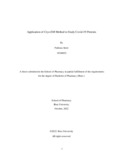| dc.contributor.advisor | Sharmin, Sabrina | |
| dc.contributor.author | Akter, Farhana | |
| dc.date.accessioned | 2023-06-26T06:03:26Z | |
| dc.date.available | 2023-06-26T06:03:26Z | |
| dc.date.copyright | 2022 | |
| dc.date.issued | 2022-10 | |
| dc.identifier.other | ID 18346032 | |
| dc.identifier.uri | http://hdl.handle.net/10361/18659 | |
| dc.description | This thesis is submitted in partial fulfillment of the requirements for the degree of Bachelor of Pharmacy, 2022. | en_US |
| dc.description | Cataloged from PDF version of thesis. | |
| dc.description | Includes bibliographical references (pages 41-44). | |
| dc.description.abstract | Researchers from all around the globe are working quickly to utilize cryo-electron
microscopy (cryo-EM) to explain how the corona virus disease (COVID-19) infects
human cells, in tandem to the global community's efforts to stop the spread of the illness
and cure individuals who have been diagnosed. Through the use of cryo-EM, these
researchers were able to determine the spike protein's structural characteristics as well as
that of the virus' cellular receptor. Cryo-EM, which studies the structure of physiologically
significant molecules like proteins and pathogens at almost atomic resolution to easily
grasp 3D structure and activity, has emerged in recent years as a popular and successful
approach for biological research. The creation of vaccinations and the advancement of
COVID-19 therapies will be facilitated and accelerated by these discoveries. Public access
to the research team's cryo-EM structures is now possible. About seven years ago, cryo-
EM began to be used more widely as improvements in electron detectors, software,
productivity, and other critical elements made it possible for scientists to resolve crucial
biological material at better resolution. A lot of work has been achieved in understanding
the structure and dynamics of the corona virus in far less than two months. In the past, it
may have taken years to advance to this level. This article will be reviewing the
applications of the Cryogenic electron microscopy for studying and understanding the
characteristics of protein spikes of the SARS-CoV-2, which can originate COVID-19 in
the human body. | en_US |
| dc.description.statementofresponsibility | Farhana Akter | |
| dc.format.extent | 56 pages | |
| dc.language.iso | en | en_US |
| dc.publisher | Brac University | en_US |
| dc.rights | Brac University theses are protected by copyright. They may be viewed from this source for any purpose, but reproduction or distribution in any format is prohibited without written permission. | |
| dc.subject | Cryo-EM | en_US |
| dc.subject | Covid-19 | en_US |
| dc.subject | Corona viruses | en_US |
| dc.subject | Vaccination | en_US |
| dc.subject | SARS-CoV-2 | en_US |
| dc.subject | Protein spikes | en_US |
| dc.subject.lcsh | Covid-19 (Disease) | |
| dc.subject.lcsh | Coronavirus infections | |
| dc.title | Application of cryo-EM method to study Covid-19 proteins | en_US |
| dc.type | Thesis | en_US |
| dc.contributor.department | Department of Pharmacy, Brac University | |
| dc.description.degree | B. Pharmacy | |

